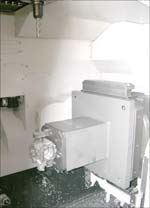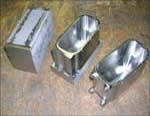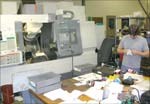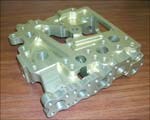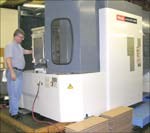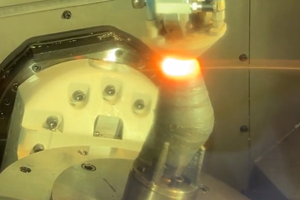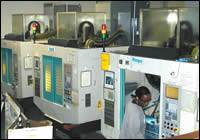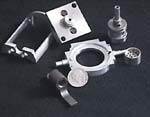Machining Centers Reconsidered
A stable customer relationship gave this shop the chance to fundamentally change its equipment.
Share





One potential advantage of serving the medical industry is reliable demand. In any economy, people will always want to live longer. They will always want to live healthier. They will always want to have better knees.
Mack Tool & Engineering is a contract manufacturer in South Bend, Indiana, that serves both medical and aerospace customers—making intimate components for human bodies and for aircraft fuel and control systems. CNC machining is the shop's core competency, and part of the shop's expertise lies in machining complex forms out of solid stock so that customers don't have to use castings or forgings.
As contrasted with the medical work, the shop's aerospace business is not so reliable. Any of a number of factors can cause demand to drop off. Military funding can decline, political administrations can change and airlines can fall on hard times. And even when the work does continue, the margins might not, because customers in this sector frequently press for price concessions. The income is even less consistent than the work is.
This kind of inconsistency leads to a common dilemma. While a shop might wish to serve its customers better using different equipment, the shop can't buy that equipment without the expectation of a stream of income to cover the payments.
For Mack Tool, the medical work helped solve that dilemma. To be more specific, Mack Tool currently serves just one customer in that industry, but the customer has proven to be a source of business the shop could rely on over a period of years. To continue to improve its service to that customer, the shop long ago made the decision to aggressively invest the income from this work back into the shop's own capabilities. That commitment has proven to be instrumental to the shop's success. The demands of the medical machining and the aerospace machining are similar enough that the capabilities able to serve one apply to the other as well. Improved capabilities ultimately made this shop more attractive to customers in both industries, and those capabilities also made the shop better equipped to meet the aerospace customers' price demands.
How aggressively does the shop invest? Aggressively enough that the justification doesn't always matter. For example, engineering vice president Paul Hartz said he tried to document the savings that would result from abandoning the shop's existing CAD/CAM system in favor a more expensive one, but ultimately, he couldn't predict what those savings would be. So he bought the software anyway. To use his words, adopting the most capable technology is simply "the way to go."
He learned that lesson from experience. One of the experiences that helped to teach him the value of technology was the shop's dramatic change in the way it makes its parts. Mack Tool used to run high-end parts on low-cost machines, using vertical machining centers with tilting rotary tables to produce intricate milled features at complex angles. Mr. Hartz was proud of his shop's ability to realize the potential of the low-cost machines in this way. Using higher-priced horizontals was illogical, he thought. Why buy a horizontal for an amount of money that might buy four vertical machines instead?
But the shop bought one such horizontal anyway, just to see what would happen.
Now there are five horizontal machining centers in this shop. And the shop is nearly finished with transitioning its high-end work entirely away from the previous machines.
A Change Of Hartz
The thinking changed. Mr. Hartz says he used to believe that having more machines naturally translated to greater capacity. Yes, some machines are more efficient than others, but on the surface, it did not seem that any horizontal could offer nearly enough efficiency to justify a factor-four difference in price.
What this analysis overlooked, he says, were the efficiency improvements waiting beneath the surface. Once the first horizontal was introduced to the process, the shop began to recognize how the transition from a vertical to a capable horizontal machine would affect not only cycle time and setups, but also inspection, leadtime and work flow. The complete benefit was not to be found in details such as specifications and pallets alone, but also in the opportunity to completely re-envision the process.
Why buy a horizontal? The price of the machine can be seen a different way, says Mr. Hartz. Most of the shop's horizontals are four-axis Mazak PFH4800 machines. For one of these machines, at recent interest rates, Mr. Hartz says the price difference for the horizontal, compared to a vertical the shop might have bought instead, came to about $2,500 per month. For that $2,500 monthly payment, the shop gets a long list of benefits.
Here are the benefits he has found:
1. Two Pallets Per Machine
Loading a part on the rotary table mounted on a vertical machining center used to interrupt machining. With a horizontal, the operator sets up one part while the current part is in work. The machine spends more of its time cutting.
2. More Efficient Use Of Labor
With horizontals, fewer machines do the same work. That means fewer operators do the same work as well.
3. More Tools In The Magazine
The significance of this advantage proved to be enormous, Mr. Hartz says. Each of Mack Tool's horizontals has the capacity for 120 tools. On average, the shop's medical parts require 35 tools per job, and the shop's aerospace parts require far more than this. Because that number exceeds the tool capacity of any of the shop's verticals, tool capacity alone could force the shop to divide a given part into multiple operations.
Now, not only is there the chance to machine the part nearly to completion in a single cycle, but there is also the chance to carry redundant tools in the magazine so a dull tool or a tool break doesn't have to interrupt production.
4. Less Inspection
In many cases, better rigidity lets the horizontal machines reliably produce features that the shop would otherwise have to measure and re-machine. There is less "chasing tolerances" today.
But even when this is not the case, the chance to consolidate a part's machining into fewer operations produces inspection time savings on its own. The shop used to have to inspect an incomplete part as it was leaving one operation to go to the next. The shop was measuring features that wouldn't exist when the part was done. Today, this wasteful mid-process inspection is much less common.
5. Heavier Cutting
The improved rigidity of Mack's horizontals also allows the machines to cut faster and deeper, achieving a higher metal removal rate. To extend this benefit, the shop recently bought a 50-taper horizontal that it uses for hogging out steel.
6. Shorter Leadtimes
Fewer setups, less inspection and faster cutting all combine to make the shop more responsive. The shop can adapt to changes more quickly, and the shop is better able to meet tight delivery commitments.
That responsiveness is particularly apparent when the shop machines prototypes, says Mr. Hartz. In the businesses this shop serves, prototyping is a fact of life, and in the past, this prototyping could be scary. The machining process for any prototype is (by definition) unproven. So when the shop had to divide one of these parts into four or five different operations, it could find itself precariously extended whenever two or three operations were done. By that point, the shop already had a large investment in the part, and it had already used much of the available leadtime. If the very next operation scrapped the part, then all of that investment and all of that time would be lost.
Today, the fear of prototypes is gone. "Now that we have 120 tools in the magazine," says Mr. Hartz, "I can find out pretty quickly whether our process will produce a good part."
Related Content
How to Mitigate Chatter to Boost Machining Rates
There are usually better solutions to chatter than just reducing the feed rate. Through vibration analysis, the chatter problem can be solved, enabling much higher metal removal rates, better quality and longer tool life.
Read More5 Tips for Running a Profitable Aerospace Shop
Aerospace machining is a demanding and competitive sector of manufacturing, but this shop demonstrates five ways to find aerospace success.
Read MoreAdditive/Subtractive Hybrid CNC Machine Tools Continue to Make Gains (Includes Video)
The hybrid machine tool is an idea that continues to advance. Two important developments of recent years expand the possibilities for this platform.
Read MoreInside a CNC-Machined Gothic Monastery in Wyoming
An inside look into the Carmelite Monks of Wyoming, who are combining centuries-old Gothic architectural principles with modern CNC machining to build a monastery in the mountains of Wyoming.
Read MoreRead Next
Vertical Machining Centers For Volume Production
At this model plant for lean manufacturing, Parker Hannifin personnel became convinced that the simple approach was the strongest choice for the application. Part of the lesson learned at this plant is that the most difficult part of going lean may lie in the discussion.
Read MoreThe Long View On Short-Run Work
This shop doesn’t know what parts it will machine tomorrow, but it has a good idea who its customers will be well into the future.
Read MoreRegistration Now Open for the Precision Machining Technology Show (PMTS) 2025
The precision machining industry’s premier event returns to Cleveland, OH, April 1-3.
Read More












